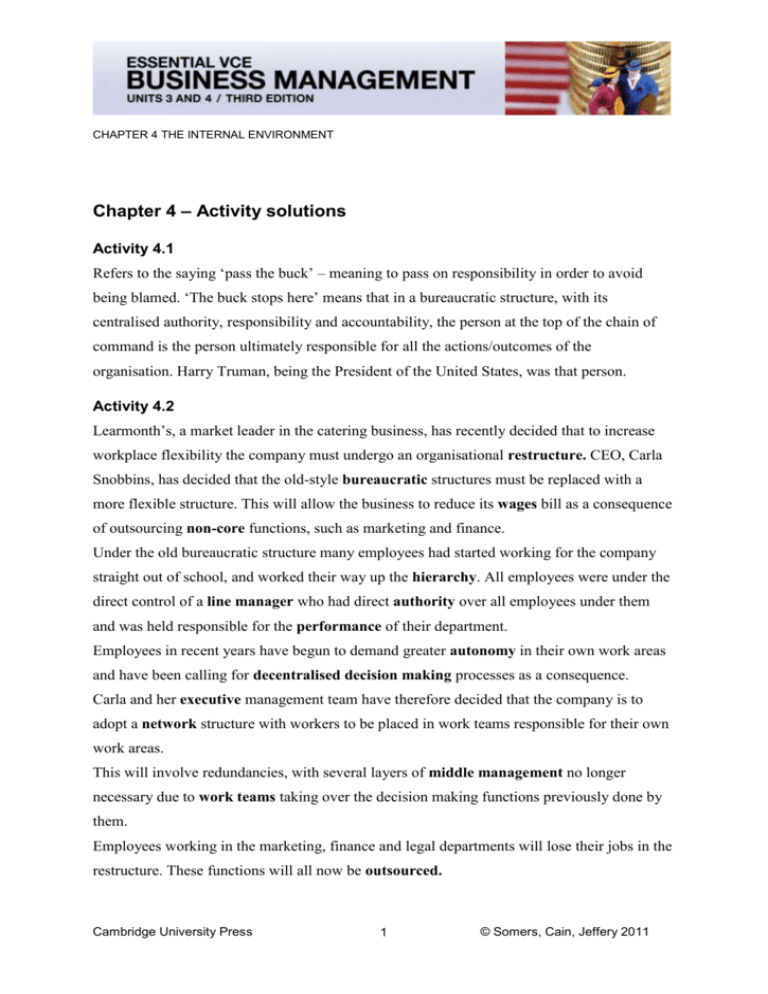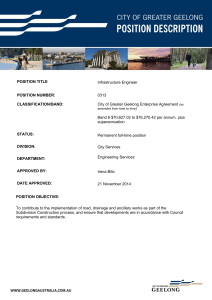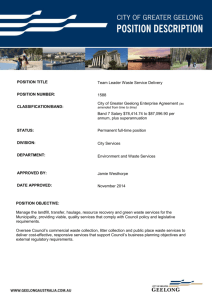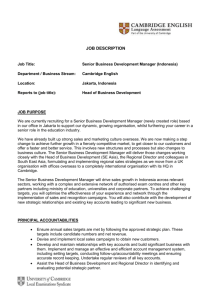Solutions - Textbook Activities - SCSC Year 12 Business Management
advertisement

CHAPTER 4 THE INTERNAL ENVIRONMENT Chapter 4 – Activity solutions Activity 4.1 Refers to the saying ‘pass the buck’ – meaning to pass on responsibility in order to avoid being blamed. ‘The buck stops here’ means that in a bureaucratic structure, with its centralised authority, responsibility and accountability, the person at the top of the chain of command is the person ultimately responsible for all the actions/outcomes of the organisation. Harry Truman, being the President of the United States, was that person. Activity 4.2 Learmonth’s, a market leader in the catering business, has recently decided that to increase workplace flexibility the company must undergo an organisational restructure. CEO, Carla Snobbins, has decided that the old-style bureaucratic structures must be replaced with a more flexible structure. This will allow the business to reduce its wages bill as a consequence of outsourcing non-core functions, such as marketing and finance. Under the old bureaucratic structure many employees had started working for the company straight out of school, and worked their way up the hierarchy. All employees were under the direct control of a line manager who had direct authority over all employees under them and was held responsible for the performance of their department. Employees in recent years have begun to demand greater autonomy in their own work areas and have been calling for decentralised decision making processes as a consequence. Carla and her executive management team have therefore decided that the company is to adopt a network structure with workers to be placed in work teams responsible for their own work areas. This will involve redundancies, with several layers of middle management no longer necessary due to work teams taking over the decision making functions previously done by them. Employees working in the marketing, finance and legal departments will lose their jobs in the restructure. These functions will all now be outsourced. Cambridge University Press 1 © Somers, Cain, Jeffery 2011 CHAPTER 4 THE INTERNAL ENVIRONMENT Activity 4.3 1 Set out below are some examples of indicators that students could include in their explanation. a Relaxed b Formal c Positive, appreciative of contribution of staff to organisation’s performance d Caring and recognising staff as having responsibilities outside the workplace e Formal and unapproachable f Value staff input and worth, open to variety of ideas g Rigid and all things must be performed to a specific pattern/way h Lacks diversity, not demonstrating tolerance i It demonstrates ethical and socially responsible values and beliefs j Appreciate their employees for their competency and trust and believe they will do the right thing to get the work done. 2 Students’ answers may vary as this task requires personal research. However, their responses should address areas such as: • uniforms – do they wear them or not? • colour scheme – what do the colours indicate? • website design – is it easy to find out information about the organisation or are they guarded in their approach and difficult to find out information? • management structure – do they adopt a bureaucratic or flatter structure? • employees – how diverse are they, e.g. age, ethnic background, gender? Activity 4.4 1 Students’ answers may vary as this task requires personal research. 2 Students’ answers may vary as this task requires personal research. However, students need to describe key aspects of culture of their school and then make comparisons to another school – this could be another secondary college or their primary school. Cambridge University Press 2 © Somers, Cain, Jeffery 2011 CHAPTER 4 THE INTERNAL ENVIRONMENT Activity 4.5 1 From the list below, students are to choose four and then explain how they assist in the learning process. • Stories and narratives • Rituals • Material symbols • Behaviour of management • Recognition and reward systems • Communication 2 a Using the word ‘Sir’ when addressing a manager indicates a high degree of formality and that the organisation is not very egalitarian in its approach. It would appear that there is a definite hierarchy and there will possibly be many material symbols indicating the level of hierarchy at which the ‘manager’ sits, e.g. relative office space, company car. b That staff are not appreciated or management has the expectation that staff will work autonomously but must be highly regulated and supervised in everything they do. c A formal dress code indicates a level of control and conformity. Activity 4.6 1 a Corporate culture is the shared values and beliefs shared by people within an organisation. It can act to influence the actions and decision making style of both managers and employees. b Policies are written statements detailing processes, procedures, rules and regulations. They reflect the organisation’s mission and objectives and should provide the guiding or governing principles that mandate or constrain the actions of people within the organisation. 2 Gender discrimination that unfairly favours men in both pay and promotion. They are seeking damages for emotional distress resulting from discrimination and loss of income. Cambridge University Press 3 © Somers, Cain, Jeffery 2011 CHAPTER 4 THE INTERNAL ENVIRONMENT 3 The corporate culture acts to discriminate against female employees because the culture is embedded into company-wide policies and practices that result in unchecked gender bias. 4 Evidence of discrimination – they claim that female employees are paid less and promoted less often than their male colleagues with equivalent experience and abilities. 5 a Affirmative action laws – this will impact on their ratio of females/males in senior management positions, which at the moment is low, e.g. 29% vice-presidents, 17% managing directors. b Negative publicity and poor public image resulting from lawsuit – Goldman Sachs will find that they may have difficulty recruiting females to their staff at the lower levels as potential female employees would feel that their advancement and pay would not be as well recognised as their male colleagues. c Resignation of high-profile employees from the company – Vice President, MD and an associate – this would hopefully cause Goldman Sachs to review their current corporate culture and to make it more equal for both male and female employees. Activity 4.7 1 City of Greater Geelong and the Geelong Football Club established a smoke-free policy for Skilled Stadium. 2 Reasons for introduction – recognition that passive smoking is hazardous to health; protection for non-smokers; create a healthy, safe and clean environment for patrons, staff and visitors; preference of patrons to view games in a smoke-free environment; compliance with legislation and protecting themselves from negligence litigation. 3 Stakeholder groups • Patrons and visitors want to visit the venue to see the game without having to put up with the effects of passive smoking. • Players want a smoke-free environment so they are able to keep healthy. • Staff want a clean and healthy workplace. • City of Greater Geelong and Geelong Football Club want to provide a venue for sport that is healthy and safe and compliant with legislative requirements. Cambridge University Press 4 © Somers, Cain, Jeffery 2011 CHAPTER 4 THE INTERNAL ENVIRONMENT 4 Internal pressure coming from staff, players and management of Geelong Football Club and external pressures from visitors, patrons, City of Greater Geelong and Federal legislation have all led to the change in policy. Responding to these pressures has made the Geelong Football Club legally, ethically and socially responsible. 5 Procedures for offenders • Assume patron is unaware of policy, advise them to extinguish cigarette or move to area outside the venue. • If patron lights up again and refuses to move outside the venue, immediately contact your supervisor or security staff. • Even if the offender has stopped smoking when security arrives, because they have received two warnings, security will remove them from the premises. • Police assistance should be sought if any physical intervention is required. 6 It is important to have such a detailed procedure so that staff know what to do and feel they are supported. 7 Staff training about the policy and how the procedures are to be implemented. This is important as it empowers the employees to act on the policy and to administer it fairly and consistently. 8 If the policy was not introduced, the City of Greater Geelong and the Geelong Football Club would be in breach of legislative requirements, leaving themselves open to litigation, and also would not be acting in a socially responsible manner. Activity 4.8 1 Students are to visit the website and then write their description of Honda Australia. 2 Social responsibility is a priority indicated by ‘we acknowledge our responsibilities to the community and the environment in which we work and will always seek to improve the areas in which we work for the benefit of future generations’. 3 Environmental objectives • Compliance with ISO14001 and adherence with statutory regulations. • Efficient use of energy from non-renewable sources and minimisation of greenhouse gas emissions. Cambridge University Press 5 © Somers, Cain, Jeffery 2011 CHAPTER 4 THE INTERNAL ENVIRONMENT • In operations – minimal waste, pollution and maintaining effective recycling programs. • Ensuring franchised dealers are adopting CSR principles. • Working with suppliers to achieve sound environment practices. • Promoting awareness of and training in environmental issues. • Reviewing, evaluating and striving for continuous improvement in environmental issues. 4 Examples of pressures likely to have led to Honda Australia adopting its environmental policy: External Globalisation – ensuring the company is meeting global standards/approaches to environmental issues. Customers – wanting to purchase cars from an environmentally responsible and sustainable company. Competitors – what are other car companies doing in this area? Government – compliance with standards. Internal Board of directors and management – wanting Honda Australia to be setting the standard/benchmark for environmental sustainability and social responsibility. 5 a Image – positive both for the broader community and also for current and potential customers. b Compliance – meet their compliance needs, therefore protecting the organisation from prosecution. c Market share – not guaranteed to increase, especially if they are not the only car company to adopt this policy approach. 6 a Employees should have a feeling of pride working for an environmentally and socially responsible employer and should be willing to engage in new work practices. b Customers may be interested in buying a new car that is based on environmental construction methods, with its construction having a reduced environmental footprint. Cambridge University Press 6 © Somers, Cain, Jeffery 2011 CHAPTER 4 THE INTERNAL ENVIRONMENT c Shareholders should receive a higher dividend if Honda is more efficient in what it does – has more customers buying cars and, as a result, increasing profits. Shareholders who have an interest in investing in a ‘green’ company would also be satisfied. Activity 4.9 1 Aim of the campaign of Oxfam is to be part of a global push to persuade sports brands to respect workers’ rights. 2 Targeted organisations are Nike, FILA, Adidas, Puma, New Balance and Asics. Oxfam is trying to pressure them to increase pay, reduce working hours, stop workplace violence, create safe working conditions for employees and allow trade union representation. 3 Oxfam is highlighting these issues through the media, and joining with other interest groups in East Asia and South Asia that are educating workers about their rights, helping them to organise trade unions and pressuring governments and companies to respect labour rights. 4 Students undertake own research. 5 Students describe what they believe are the possible impacts on Nike’s policy. Activity 4.10 Students’ answers may vary as this task requires personal research and students need to access the websites listed in the activity. Cambridge University Press 7 © Somers, Cain, Jeffery 2011




